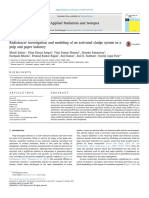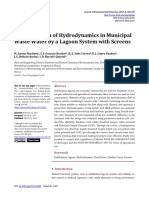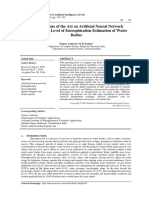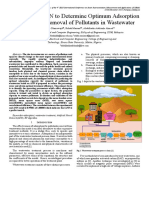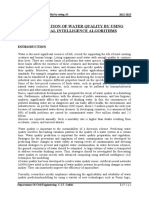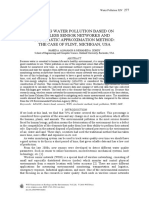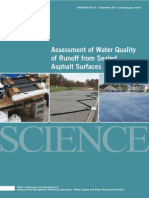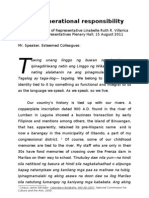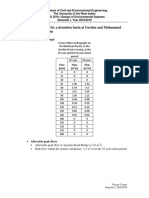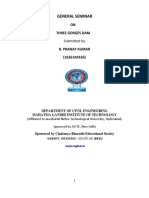Professional Documents
Culture Documents
Prediction of Wastewater Treatment Plant Using Genetic Algorithm
Copyright
Available Formats
Share this document
Did you find this document useful?
Is this content inappropriate?
Report this DocumentCopyright:
Available Formats
Prediction of Wastewater Treatment Plant Using Genetic Algorithm
Copyright:
Available Formats
Volume 8, Issue 1, January – 2023 International Journal of Innovative Science and Research Technology
ISSN No:-2456-2165
Prediction of Wastewater Treatment Plant Using
Genetic Algorithm
AKSHATHA KAMATH
Assistant Professor
Dept. of Computer Science and Engg.,
Ramaiah Institute of Technology Bangalore, India
Abstract:- A prediction of the wastewater treatment plant If waste water is not adequately handled, it can have a
(WWTP) using a genetic algorithm based on historical severe influence on the environment and human health.
data. In Iran, the majority of treated wastewater is used Damage to fish and mammal populations, oxygen depletion,
in agriculture. As a result, using waste water with poor beach closures, and other limits on recreational water usage
quality attributes might be hazardous to one's health. The are only a few of the consequences. The goal of waste water
effectiveness of the neural network model in predicting treatment is to remove as many suspended solids as possible
performance was investigated in this study. To find before releasing the effluent into the environment.
relationships in the data, exploratory data analysis was
employed and evaluated at a dependency level. The neural The amount of dissolved oxygen (DO) consumed by
network models' proper architecture was identified biological organisms when they degrade organic substances
through a series of training and testing stages. The ANN- in water is measured by the biochemical oxygen demand
based models were discovered to be a useful and reliable (BOD). The amount of oxygen consumed when a water
tool for predicting WWTP performance. The activated sample is chemically oxidized is known as the chemical
sludge method will be considered as a replacement for the oxygen demand (COD). Low concentrations of BOD and
semi-mechanical treatment system. COD can create eutrophication and destroy aquatic life,
lowering the DO of lakes and rivers. Water with high
Keywords:- Wastewater, ANN, Neuralnetwork, COD/BOD levels can be produced by municipal wastewater
Geneticalgorithm. discharge and industrial activities, necessitating thorough
treatment before discharge to protect the health of rivers.
I. INTRODUCTION
Biological approaches, such as adding microorganisms
The process of transforming waste water into water that and creating favorable circumstances for the organic matter
can be discharged back into the environment is known as to break down quickly, are widely used to treat BOD. Return
waste water treatment. Wastewater treatment is one of the activated sludge (RAS) is a bacterium source often used in
most frequent ways of pollution control in the United States, sewage treatment plants to remove organics in the water. To
according to the US EPA. The goal of wastewater treatment forecast the influence of changes in the parameters of an
is to speed up the natural purification processes. anaerobic B-2 system on its performance, an artificial neural
network was employed, and the weights of the artificial
Bathing, washing, using the toilet, and rainwaterrunoff neural network were optimized using a parallel multi-
all contribute to the formation of wastewater. Wastewater is population genetically algorithm. These researchers' findings
simply used water that has been contaminated by home, revealed that combining these methodologies can provide a
industrial, and commercial activities. According to the Safe useful tool for anticipating changes in anaerobic system
Drinking Foundation, some waste waters are more difficult performance. The researchers also found that these
to treat than others. Industrial effluent, for example, can be techniques can beexpanded to other treatment systems due to
difficult to treat due to its high strength. On the other hand, their adaptations to various environmental circumstances. A
dealing with domestic waste water is quite simple. genetic algorithm and an artificial neural network were used.
Apart from oxygen, water will most likely be the most
Given that not all trash makes it to wastewater treatment important resource for interplanetary space flight. All living
plants, there are a variety of ways in which wastewater can things require water to survive. Most long-duration space
cause environmental issues. Combined sewer systems (CSS) journeys will require some form of water purification and
collect residential sewage in the same pipes as storm water recycling in the future. The application of genetic algorithms
runoff in many cities, particularly older ones. Following to the optimization of waste water treatment design is the
severe rains, street gutters gather more water than the system subject of this research article The Activated Sludge Model
can contain, and a mixture of raw sewage and storm water is no.1 of the International Association on Water Pollution
released directly into the environment, resulting in a Research and Control (IAWRC), as well as the mathematical
combined sewer overflow (CSO). solution to the model, will be reviewed first. The four-stage
Bardenpho procedure is then described as the design that will
be optimized in this situation. Finally, the genetic algorithm
IJISRT23JAN444 www.ijisrt.com 1302
Volume 8, Issue 1, January – 2023 International Journal of Innovative Science and Research Technology
ISSN No:-2456-2165
is investigated, with future research objectives taken into
account.
II. MATERIALS AND METHODS
Perkandabad waste water treatment facility No. 1
(Figure 1), which is located on the southern bank of the
seasonal river, is one of Mashhad's most important municipal
wastewater treatment plants. This treatment facility has a
nominal capacity of 15200 cubic metres per day, and it serves
a population of 100000 people. The raw wastewater is treated
by passing through the waste collecting unit, aeration
lagoons, sedimentation ponds, execution pond, and
disinfection unit in this treatment plant, which uses an
aerated lagoon with complete mixing. The design of this
treatment facility is based on surface water discharge since
effluent from the Perkandabad No.1 treatment plant is
discharged into the river at specific periods of the year. Statistical indicators such as the correlation coefficient,
mean square error, and root mean square error were employed
during the results analysis to describe the error rate and
compare the simulated parameters. The parameters affecting
the treatment plant's performance were determined using
quantitative and qualitative data from entering wastewater,
effluent, process conditions, climatic data, and, lastly, the
effluent. The concentrations of parameters in the effluent
were then predicted using the determined factors and the
neural network model. A genetic algorithm was utilized to
optimize the neural network in order to attain higher accuracy
in refinery modelling. Finally,the concentration of each of the
three parameters in the effluent was predicted using the
correlation coefficient R and the statistical criteria of mean
relative root mean squared prediction The mean absolute
percentage of relative error (rMAPE) and the root mean
squared percentage of relative error (rRMSPE) were
calculated with their actual values, and the model was
evaluated [17].
III. RESULTS
The genetic algorithm in this work looked for the best
response for 450 generations, evaluating 150 possible
solutions in the search space each generation. The effluent
Fig 1: Waste water Treatment Plant summarizes the results of five model runs for the BOD
parameter. Due to the semi-modern character of the
BOD5 (BiochemicalOxygenDemandin5days), COD treatment plant, the highest and minimum values of the
(Chemical Oxygen Demand), TSS (Total Suspended Solids), correlation coefficient of the findings derived from the
and pH were the parameters tested for waste water quality model were 0.93, 0.86, and 1.08, respectively. The average
assessment. Meteorological data, such as average daily air of these values was found to be a satisfactory number. It
temperature, sunshine duration, and daily rainfall, were also shows the TSS, BOD, and COD parameters of a waste water
utilized. To begin modelling the neural network, the data was treatment plan's predictive outcomes. Parameter
partitioned randomly for testing. Figure 2 depicts the input RMSEBOD0.892.3COD0.82TSS 0.83 2.07
and output data, as well as the model architecture. RMSEBOD0.892.3COD0.82TSS 0.83 2.07 The number of
selected neurons in the first and second hidden layers
revealed that the network had failed in 16% of situations.
There are two hidden layers, with an average of 16 neurons
in the first layer and 11 neurons in the second layer. The
network had only one hidden layer in the remaining 84
percent, with an average of 14 neurons. The optimum
network structure had two hidden layers, with 15 neurons in
the first layer and 2 neurons in the second layer on average.
At the greatest value of the correlation coefficient, the
IJISRT23JAN444 www.ijisrt.com 1303
Volume 8, Issue 1, January – 2023 International Journal of Innovative Science and Research Technology
ISSN No:-2456-2165
network comprised only one hidden layer with 11 neurons the highest correlation coefficient. For the structure and
(R). The GA-ANN model, which had a maximum correlation weight of the features in this scenario, the average number of
coefficient of 0.93 and rRMSPE and rMAPE error rates of neurons in each layer and the mean weight of the features in
10% and 7%, respectively, was an effective model for 15 times of model execution were used. In the first scenario,
predicting the concentration of the TBOD parameter and putting the model concerning the TBOD parameter into
produced correct findings. . As a result, it can be used to practise yielded superior results, as shown in Figure 3. These
simulate treatment plants. Parameters impacting microbe concentrations in the wastewater are substantially greater than
growth and activity, such as input TCOD in/TBOD in ratio, the usual TBOD value. As a result, it is critical to execute
dissolved oxygen content, aeration lagoon temperature, and appropriate strategies to improve effluent quality as soon as
input TBOD load, were also prioritised in the model feasible, as well as to ensure the efficacy of the solutions and
predictions due to biological treatment. The parameters the actual improvement of effluent quality at various phases,
affecting the performance of the specified treatment were as predicted by the model..
determined based on the results received from the optimised
artificial network model for the TBOD parameter. It shows a
summary of their findings, as well as the weights assigned to
each parameter. It shows a summary of the elements that are
successful in forecasting the effluent's TBOD parameter, as
well as the weights that are unrelated to it. Important factors
to consider The importance of feature weight in predicting
TBOD levels Aerator Num 0.66 TL 0.85 TAIR 0.73 Q 0.8
DO 0.88 Input pollution load TBOD 0.89 Aerator Num 0.66
TL 0.85 TAIR 0.73
Two characteristics (discharge and pollution load) are
among the input parameters in the table above that play a
crucial role in determining waste water quality. Based on the
available data, it was discovered that in most situations, the
flow rate exceeds the specified flow rate, and one of the
possible remedies is to reduce the input flow rate.Dissolved
oxygen (DO) and lagoon temperature were the most
important process parameters in predicting effluent TBOD.
The type of aeration system and its rate, in general, can have
a direct impact on dissolved oxygen. The temperature of the
lagoon and the rate of TSS precipitation are both effective.
The use of a deep aeration system rather than surface aeration IV. CONCLUSIONS
is one of the greatest ways to improve the performance of the
treatment plant because it efficiently improves the As a result, it is critical to monitor BOD and COD in
concentration of dissolved oxygen, raises the temperature of wastewater in order to prevent environmental pollution and to
the aeration lagoon content, and provides the appropriate save the lives of aquatic animals and fish. RLT offers modern
mixing. Due to the open nature of the aeration lagoon system, technology BOD and COD analyzers that can provide precise
it is practically and directly impossible to manage the effect data in real time. According to the findings, the inlet flow rate,
of air temperature (TAIR) on the treatment system. The effect TCODin/TBODinratio, temperature, and load of organic
of air temperature on the temperature of the aeration lagoon matter in the incoming wastewater, as well as the amount of
content can be decreased by utilizing deep aerators instead of dissolved oxygen, temperature, and pH in lagoon content, and
surface aerators. Surface aerators lose the most heat energy several active aerators, were the most important factors
since the air is more in touch with the aeration lagoon's affecting the Mashhad treatment plant's performance. Air
surface. The volume of inflow, according to the test results of temperature and the quantity of sunshine hours were two
this study, was the most relevant criterion in determining the climate elements that influenced performance. The neural
quality of waste water. The inlet flow rate to the treatment network model was optimized using a complete search
plant in the following years can be determined with a good genetic search technique, and the results showed a maximum
approximation based on the statistics and in the formation of correlation coefficient of 0.89 for the TBOD parameter and
the project. In the given plan, the rate of rise of TBOD and corresponding rRMSPE and rMAPE for the qualitative
TSS input concentration for every 10 years is equal to 5%. As parameter of 10% and 7%, respectively. Among process
a result of this rising trend, the annual concentration of factors - dissolved oxygen concentration, lagoon content
TBOD and TSS of waste water entering the treatment plant temperature, and several active aerators - the neural network
between 2021 and 2025 is anticipated to reach 1.005. The model singled out important parameters in predicting the
model was deployed in two modes to forecast the effluent concentration of TBOD parameter in the effluent -discharge
quality assuming no corrective action to improve the rate and a load of organic matter pollution of incoming
treatment plant's performance. The network topology and wastewater, and from climatic conditions - air temperature.
weight of the features were examined in the first case In comparison to other inlet characteristics, the inlet
scenario, which was based on the case where the model had discharge of the examined treatment plant had a higher weight
IJISRT23JAN444 www.ijisrt.com 1304
Volume 8, Issue 1, January – 2023 International Journal of Innovative Science and Research Technology
ISSN No:-2456-2165
in predicting the concentration of the TBOD parameter of the
effluent. As a result, in order to optimize the performance of
the aforementioned treatment plant, suitable steps should be
done to lower and control the incoming flow to various
treatment plant units.
REFERENCES
[1]. Optimization Of Pharmaceutical Wastewater Treatment
By Biosorption Using Genetic Algorithm Ola Belal
Hasan Abdallah1*, Priy Brat Dwivedi2
[2]. Qualitative evaluation of wastewater treatment plant
performance by neural network model optimized by
genetic algorithm Sara Dadar 1 , Atena Pezeshki 1 ,
Bojan Đurin 2,*, Dragana Dogančić
[3]. Zhao W, Beach TH, Rezgui Y. 2018 A systematic
mixed-integer differential evolution approach for water
network operational optimization.Proc. R. Soc. A 474:
20170879
[4]. Optimal control for wastewater treatment process based
on an adaptive multi_objective differential evolution
algorithm by Qian, Jun-Fie,Ying:Hong- Gui
[5]. Cristina Tuser is Associate Editor for WWD.
Tuser can be reached at ctuser@sgcmail.com.
[6]. Clean TeQ Water provides tertiary treatment of
wastewater, polishing nutrients or improving water
quality once the majority of COD and BOD has been
removed.
[7]. Xie, Y.; Chen, Y.; Lian, Q.; Yin, H.; Peng, J.;Sheng, M.;
Wang, Y. Enhancing Real- Time Prediction of Effluent
Water Quality of Wastewater Treatment Plant Based on
Improved Feedforward Neural Network Coupled with
Optimization Algorithm. Water2022, 14, 1053
[8]. OPTIMIZATION OF W ASTEW ATER DESIGN
USING GENETIC ALGORITHMS D. Starr Stanfield
by RLT Solutions | Jun 18, 2021 | Water Quality
Monitoring System
IJISRT23JAN444 www.ijisrt.com 1305
You might also like
- Industrial Water Treatment Process TechnologyFrom EverandIndustrial Water Treatment Process TechnologyRating: 2.5 out of 5 stars2.5/5 (3)
- Jem WWTPDocument12 pagesJem WWTPvacomanoNo ratings yet
- Sustainability 14 15598Document35 pagesSustainability 14 15598Simón OsésNo ratings yet
- Intelligent System For The Predictive Analysis of An Industrial Wastewater Treatment ProcessDocument19 pagesIntelligent System For The Predictive Analysis of An Industrial Wastewater Treatment ProcessNarendra AjmeraNo ratings yet
- Domestic Wastewater Treatment by Root Zone Technology Option: Colacassia PlantDocument6 pagesDomestic Wastewater Treatment by Root Zone Technology Option: Colacassia PlantIJEMR JournalNo ratings yet
- Domestic Wastewater Treatment by Root Zone Technology Option: Colacassia PlantDocument6 pagesDomestic Wastewater Treatment by Root Zone Technology Option: Colacassia PlantIJEMR JournalNo ratings yet
- Bioresource TechnologyDocument11 pagesBioresource TechnologyShaik HussainNo ratings yet
- Introduction To Waste Water Treatment by Root Zone TechniqueDocument4 pagesIntroduction To Waste Water Treatment by Root Zone TechniqueAnonymous kw8Yrp0R5rNo ratings yet
- Literature Survey On Smart Water Quality Monitoring SystemDocument5 pagesLiterature Survey On Smart Water Quality Monitoring SystemInternational Journal of Innovations in Engineering and ScienceNo ratings yet
- Ponds & Lake Solar-Powered Water Body CleanerDocument3 pagesPonds & Lake Solar-Powered Water Body CleanerInternational Journal of Innovative Science and Research TechnologyNo ratings yet
- An Analytical Study On The Effectiveness of First Flush Rainwater Harvesting in Catanduanes Implications For Sustainable Water Resource ManagementDocument28 pagesAn Analytical Study On The Effectiveness of First Flush Rainwater Harvesting in Catanduanes Implications For Sustainable Water Resource ManagementTayam Prince RussellNo ratings yet
- IJETR033349Document3 pagesIJETR033349erpublicationNo ratings yet
- Applied Radiation and Isotopes: HighlightsDocument6 pagesApplied Radiation and Isotopes: HighlightsMETALI SARKARNo ratings yet
- Municipal wastewater treatment and recycle by electrocoagulation and submerged mbrDocument10 pagesMunicipal wastewater treatment and recycle by electrocoagulation and submerged mbrRabialtu SulihahNo ratings yet
- Determination of Hydrodynamics in Municipal Waste Water by A Lagoon System With ScreensDocument14 pagesDetermination of Hydrodynamics in Municipal Waste Water by A Lagoon System With ScreensShrutiNo ratings yet
- Assessing State of The Art On Artificial Neural Network Paradigms For Level of Eutrophication Estimation of Water BodiesDocument8 pagesAssessing State of The Art On Artificial Neural Network Paradigms For Level of Eutrophication Estimation of Water BodiesIAES IJAINo ratings yet
- Water Quality Monitoring and Forecasting SystemDocument75 pagesWater Quality Monitoring and Forecasting Systemdasarajubhavani05No ratings yet
- Modeling ANN to Determine Optimum Wastewater CapacityDocument5 pagesModeling ANN to Determine Optimum Wastewater CapacityJohanne BergaveraNo ratings yet
- Water 14 02836Document15 pagesWater 14 02836adrianoucamNo ratings yet
- Treatment of Milk Wastewater Using Up-Fl Ow Anaerobic Packed Bed ReactorDocument5 pagesTreatment of Milk Wastewater Using Up-Fl Ow Anaerobic Packed Bed ReactorAini ZahraNo ratings yet
- 1 s2.0 S2213343716300240 MainDocument8 pages1 s2.0 S2213343716300240 MainAndrea SánchezNo ratings yet
- Realtime Monitoring Source Tracking Water Pollution in Najafgarh Drain Before During Covid 19 Outbreak With Forems IJERTV9IS060246Document4 pagesRealtime Monitoring Source Tracking Water Pollution in Najafgarh Drain Before During Covid 19 Outbreak With Forems IJERTV9IS060246Sonal MahyavanshiNo ratings yet
- Performance Assessment of Water Filtration Plants in Pakistan MDocument15 pagesPerformance Assessment of Water Filtration Plants in Pakistan MInternational Network For Natural SciencesNo ratings yet
- Embedded water quality monitoringDocument9 pagesEmbedded water quality monitoringElavazha GanNo ratings yet
- 1 s2.0 S0925857424000429 MainDocument10 pages1 s2.0 S0925857424000429 Mainarthagarwal09No ratings yet
- Gautam2013 Article AStudyOfTheEffectivenessOfSewa PDFDocument9 pagesGautam2013 Article AStudyOfTheEffectivenessOfSewa PDFNikhil SachdevaNo ratings yet
- A Study of The Effectiveness of Sewage Treatment Plants in Delhi RegionDocument9 pagesA Study of The Effectiveness of Sewage Treatment Plants in Delhi Regionsonali kambleNo ratings yet
- Neural Based PH System in Effluent Treatment ProcessDocument11 pagesNeural Based PH System in Effluent Treatment Processmaheswaribalaji2010No ratings yet
- Ehemj v3n4p0 enDocument11 pagesEhemj v3n4p0 enJackyNo ratings yet
- Mustakim 2021 J. Phys. - Conf. Ser. 1783 012020Document8 pagesMustakim 2021 J. Phys. - Conf. Ser. 1783 012020Syaiful Ramadhan HarahapNo ratings yet
- Arora Et Al 2021Document6 pagesArora Et Al 2021Josefina CorteseNo ratings yet
- Potabilización de AguaDocument9 pagesPotabilización de AguaSHEILA GINIVA BUSTOS YAIMANo ratings yet
- Development of An Artificial Neural Network For Hydrologic and Water Quality Modeling of Agricultural WatershedsDocument6 pagesDevelopment of An Artificial Neural Network For Hydrologic and Water Quality Modeling of Agricultural WatershedsChia-YiiNo ratings yet
- Flow Design of Sewerage System - A CaseDocument4 pagesFlow Design of Sewerage System - A CaseHanafi NidzamNo ratings yet
- Artificial Neural Network Prediction of The Biogas Flow Rate Optimised With An Ant Colony AlgorithmDocument11 pagesArtificial Neural Network Prediction of The Biogas Flow Rate Optimised With An Ant Colony AlgorithmShaik HussainNo ratings yet
- Sustainability v14 I13 - 20220628Document8 pagesSustainability v14 I13 - 20220628Vemana SekharNo ratings yet
- Evaluation of Multivariate Linear Regression and Artificial Neural Networks in Prediction of Water Quality ParametersDocument8 pagesEvaluation of Multivariate Linear Regression and Artificial Neural Networks in Prediction of Water Quality ParameterszaidNo ratings yet
- SYNOPSISDocument4 pagesSYNOPSISkiran kumarNo ratings yet
- Wastewater Networks: Soft-Sensing Technique For Treatment Based OnDocument3 pagesWastewater Networks: Soft-Sensing Technique For Treatment Based OnAbcvdgtyio Sos RsvgNo ratings yet
- Caracterizacion Del Agua Superficial de Drenaje Perfil Ambiental, Nivel de Degradacion y Monitoreo GeoestadisticoDocument11 pagesCaracterizacion Del Agua Superficial de Drenaje Perfil Ambiental, Nivel de Degradacion y Monitoreo GeoestadisticoVALENTINA CASTA?EDA SANTAMARIANo ratings yet
- Testing Water Pollution Based On Wireless Sensor Networks and Stochastic Approximation Method: The Case of Flint, Michigan, UsaDocument7 pagesTesting Water Pollution Based On Wireless Sensor Networks and Stochastic Approximation Method: The Case of Flint, Michigan, UsaAlexandre OliveiraNo ratings yet
- s13568 018 0714 0Document14 pagess13568 018 0714 0charvi shinyNo ratings yet
- Sensors: A Water Quality Prediction Method Based On The Deep LSTM Network Considering Correlation in Smart MaricultureDocument20 pagesSensors: A Water Quality Prediction Method Based On The Deep LSTM Network Considering Correlation in Smart MaricultureDarelle ThorntonNo ratings yet
- Design and Analysis of Water Quality Monitoring and Filtration System For Different Types of Water in MalaysiaDocument12 pagesDesign and Analysis of Water Quality Monitoring and Filtration System For Different Types of Water in MalaysiaMary Anne YadaoNo ratings yet
- 2.ISCA IRJEvS 2016 077Document11 pages2.ISCA IRJEvS 2016 077JubairNo ratings yet
- Radiotracer investigation of pulp and paper wastewater systemDocument17 pagesRadiotracer investigation of pulp and paper wastewater systemmetaliNo ratings yet
- Using Regression Analysis To Estimate Water Quality Constituents in Bahr El Baqar DrainDocument11 pagesUsing Regression Analysis To Estimate Water Quality Constituents in Bahr El Baqar DrainDale LacastreNo ratings yet
- Utilization of SBR Technology For WastewDocument15 pagesUtilization of SBR Technology For WastewSergeo Cruz100% (1)
- Nitrogen RemovalDocument11 pagesNitrogen RemovalRamani Bai V.No ratings yet
- Constructed Wetlands: Technology For Removing Drug Concentration From WaterDocument12 pagesConstructed Wetlands: Technology For Removing Drug Concentration From WaterIJAERS JOURNALNo ratings yet
- Accepted Manuscript: 10.1016/j.cjche.2018.05.010Document30 pagesAccepted Manuscript: 10.1016/j.cjche.2018.05.010Muhammad Abdurrahman Mustafa HafizuddinNo ratings yet
- Multiparametric System For Measuring Physicochemical Variables Associated To Water Quality Based On The Arduino PlatformDocument14 pagesMultiparametric System For Measuring Physicochemical Variables Associated To Water Quality Based On The Arduino PlatformSERGIO DANILO SABOGAL QUINTINNo ratings yet
- Study On Optimization and Performance of Biological Enhanced Activated Sludge Process For Pharmaceutical Wastewater TreatmentDocument9 pagesStudy On Optimization and Performance of Biological Enhanced Activated Sludge Process For Pharmaceutical Wastewater TreatmentVijaya GosuNo ratings yet
- Baf Ed Duckweed Pond System For Treatment of Agricultural Drainage Water Containing PharmaceuticalsDocument7 pagesBaf Ed Duckweed Pond System For Treatment of Agricultural Drainage Water Containing PharmaceuticalsArchipelago Travel ToursNo ratings yet
- IoT-Based Water Monitoring SystemDocument5 pagesIoT-Based Water Monitoring SystemManuel Luis Delos SantosNo ratings yet
- Mathematical Modelling of Water Quality in Pinacanauan RiverDocument32 pagesMathematical Modelling of Water Quality in Pinacanauan RiverRhea MambaNo ratings yet
- 28-18089 Eng - Mardani IJEHSE 2011Document11 pages28-18089 Eng - Mardani IJEHSE 2011MdyoriFlrsRmsNo ratings yet
- Estimationof BODinwastewaterbyusingdifferent ANNalgorithmstreatmentplantDocument9 pagesEstimationof BODinwastewaterbyusingdifferent ANNalgorithmstreatmentplantpharmacistnafiNo ratings yet
- Process System Engineering in Wastewater Treatment ProcessDocument2 pagesProcess System Engineering in Wastewater Treatment ProcessGian Jelo SalleNo ratings yet
- The Quality of Drinkable Water Using Machine Learning TechniquesDocument8 pagesThe Quality of Drinkable Water Using Machine Learning TechniquesIJAERS JOURNALNo ratings yet
- An Analysis on Mental Health Issues among IndividualsDocument6 pagesAn Analysis on Mental Health Issues among IndividualsInternational Journal of Innovative Science and Research TechnologyNo ratings yet
- Harnessing Open Innovation for Translating Global Languages into Indian LanuagesDocument7 pagesHarnessing Open Innovation for Translating Global Languages into Indian LanuagesInternational Journal of Innovative Science and Research TechnologyNo ratings yet
- Diabetic Retinopathy Stage Detection Using CNN and Inception V3Document9 pagesDiabetic Retinopathy Stage Detection Using CNN and Inception V3International Journal of Innovative Science and Research TechnologyNo ratings yet
- Investigating Factors Influencing Employee Absenteeism: A Case Study of Secondary Schools in MuscatDocument16 pagesInvestigating Factors Influencing Employee Absenteeism: A Case Study of Secondary Schools in MuscatInternational Journal of Innovative Science and Research TechnologyNo ratings yet
- Exploring the Molecular Docking Interactions between the Polyherbal Formulation Ibadhychooranam and Human Aldose Reductase Enzyme as a Novel Approach for Investigating its Potential Efficacy in Management of CataractDocument7 pagesExploring the Molecular Docking Interactions between the Polyherbal Formulation Ibadhychooranam and Human Aldose Reductase Enzyme as a Novel Approach for Investigating its Potential Efficacy in Management of CataractInternational Journal of Innovative Science and Research TechnologyNo ratings yet
- The Making of Object Recognition Eyeglasses for the Visually Impaired using Image AIDocument6 pagesThe Making of Object Recognition Eyeglasses for the Visually Impaired using Image AIInternational Journal of Innovative Science and Research TechnologyNo ratings yet
- The Relationship between Teacher Reflective Practice and Students Engagement in the Public Elementary SchoolDocument31 pagesThe Relationship between Teacher Reflective Practice and Students Engagement in the Public Elementary SchoolInternational Journal of Innovative Science and Research TechnologyNo ratings yet
- Dense Wavelength Division Multiplexing (DWDM) in IT Networks: A Leap Beyond Synchronous Digital Hierarchy (SDH)Document2 pagesDense Wavelength Division Multiplexing (DWDM) in IT Networks: A Leap Beyond Synchronous Digital Hierarchy (SDH)International Journal of Innovative Science and Research TechnologyNo ratings yet
- Comparatively Design and Analyze Elevated Rectangular Water Reservoir with and without Bracing for Different Stagging HeightDocument4 pagesComparatively Design and Analyze Elevated Rectangular Water Reservoir with and without Bracing for Different Stagging HeightInternational Journal of Innovative Science and Research TechnologyNo ratings yet
- The Impact of Digital Marketing Dimensions on Customer SatisfactionDocument6 pagesThe Impact of Digital Marketing Dimensions on Customer SatisfactionInternational Journal of Innovative Science and Research TechnologyNo ratings yet
- Electro-Optics Properties of Intact Cocoa Beans based on Near Infrared TechnologyDocument7 pagesElectro-Optics Properties of Intact Cocoa Beans based on Near Infrared TechnologyInternational Journal of Innovative Science and Research TechnologyNo ratings yet
- Formulation and Evaluation of Poly Herbal Body ScrubDocument6 pagesFormulation and Evaluation of Poly Herbal Body ScrubInternational Journal of Innovative Science and Research TechnologyNo ratings yet
- Advancing Healthcare Predictions: Harnessing Machine Learning for Accurate Health Index PrognosisDocument8 pagesAdvancing Healthcare Predictions: Harnessing Machine Learning for Accurate Health Index PrognosisInternational Journal of Innovative Science and Research TechnologyNo ratings yet
- The Utilization of Date Palm (Phoenix dactylifera) Leaf Fiber as a Main Component in Making an Improvised Water FilterDocument11 pagesThe Utilization of Date Palm (Phoenix dactylifera) Leaf Fiber as a Main Component in Making an Improvised Water FilterInternational Journal of Innovative Science and Research TechnologyNo ratings yet
- Cyberbullying: Legal and Ethical Implications, Challenges and Opportunities for Policy DevelopmentDocument7 pagesCyberbullying: Legal and Ethical Implications, Challenges and Opportunities for Policy DevelopmentInternational Journal of Innovative Science and Research TechnologyNo ratings yet
- Auto Encoder Driven Hybrid Pipelines for Image Deblurring using NAFNETDocument6 pagesAuto Encoder Driven Hybrid Pipelines for Image Deblurring using NAFNETInternational Journal of Innovative Science and Research TechnologyNo ratings yet
- Terracing as an Old-Style Scheme of Soil Water Preservation in Djingliya-Mandara Mountains- CameroonDocument14 pagesTerracing as an Old-Style Scheme of Soil Water Preservation in Djingliya-Mandara Mountains- CameroonInternational Journal of Innovative Science and Research TechnologyNo ratings yet
- A Survey of the Plastic Waste used in Paving BlocksDocument4 pagesA Survey of the Plastic Waste used in Paving BlocksInternational Journal of Innovative Science and Research TechnologyNo ratings yet
- Hepatic Portovenous Gas in a Young MaleDocument2 pagesHepatic Portovenous Gas in a Young MaleInternational Journal of Innovative Science and Research TechnologyNo ratings yet
- Design, Development and Evaluation of Methi-Shikakai Herbal ShampooDocument8 pagesDesign, Development and Evaluation of Methi-Shikakai Herbal ShampooInternational Journal of Innovative Science and Research Technology100% (3)
- Explorning the Role of Machine Learning in Enhancing Cloud SecurityDocument5 pagesExplorning the Role of Machine Learning in Enhancing Cloud SecurityInternational Journal of Innovative Science and Research TechnologyNo ratings yet
- A Review: Pink Eye Outbreak in IndiaDocument3 pagesA Review: Pink Eye Outbreak in IndiaInternational Journal of Innovative Science and Research TechnologyNo ratings yet
- Automatic Power Factor ControllerDocument4 pagesAutomatic Power Factor ControllerInternational Journal of Innovative Science and Research TechnologyNo ratings yet
- Review of Biomechanics in Footwear Design and Development: An Exploration of Key Concepts and InnovationsDocument5 pagesReview of Biomechanics in Footwear Design and Development: An Exploration of Key Concepts and InnovationsInternational Journal of Innovative Science and Research TechnologyNo ratings yet
- Mobile Distractions among Adolescents: Impact on Learning in the Aftermath of COVID-19 in IndiaDocument2 pagesMobile Distractions among Adolescents: Impact on Learning in the Aftermath of COVID-19 in IndiaInternational Journal of Innovative Science and Research TechnologyNo ratings yet
- Studying the Situation and Proposing Some Basic Solutions to Improve Psychological Harmony Between Managerial Staff and Students of Medical Universities in Hanoi AreaDocument5 pagesStudying the Situation and Proposing Some Basic Solutions to Improve Psychological Harmony Between Managerial Staff and Students of Medical Universities in Hanoi AreaInternational Journal of Innovative Science and Research TechnologyNo ratings yet
- Navigating Digitalization: AHP Insights for SMEs' Strategic TransformationDocument11 pagesNavigating Digitalization: AHP Insights for SMEs' Strategic TransformationInternational Journal of Innovative Science and Research TechnologyNo ratings yet
- Drug Dosage Control System Using Reinforcement LearningDocument8 pagesDrug Dosage Control System Using Reinforcement LearningInternational Journal of Innovative Science and Research TechnologyNo ratings yet
- The Effect of Time Variables as Predictors of Senior Secondary School Students' Mathematical Performance Department of Mathematics Education Freetown PolytechnicDocument7 pagesThe Effect of Time Variables as Predictors of Senior Secondary School Students' Mathematical Performance Department of Mathematics Education Freetown PolytechnicInternational Journal of Innovative Science and Research TechnologyNo ratings yet
- Formation of New Technology in Automated Highway System in Peripheral HighwayDocument6 pagesFormation of New Technology in Automated Highway System in Peripheral HighwayInternational Journal of Innovative Science and Research TechnologyNo ratings yet
- Google Books: Algae Identification GuideDocument101 pagesGoogle Books: Algae Identification GuideAyan DuttaNo ratings yet
- Comments by Francis MangelsDocument2 pagesComments by Francis Mangelsapi-392139141No ratings yet
- Research WorkDocument1 pageResearch WorkMaryjoy abilaNo ratings yet
- CBR PLUS Haul Road Dust SuppressantDocument3 pagesCBR PLUS Haul Road Dust SuppressantcbrplusmexicoNo ratings yet
- Control#47 VFDocument23 pagesControl#47 VFAshraf RamadanNo ratings yet
- Water ConservationDocument32 pagesWater ConservationViral OkNo ratings yet
- Cive3223 5 2014 2Document4 pagesCive3223 5 2014 2Yannick HowNo ratings yet
- Assessment of Water Quality of Runoff From Sealed Asphalt SurfacesDocument44 pagesAssessment of Water Quality of Runoff From Sealed Asphalt SurfacesTom EnnisNo ratings yet
- Septic Tank DetailDocument1 pageSeptic Tank DetailVishnu PrajapatiNo ratings yet
- ADMIRALTY Latest PublicationsDocument1 pageADMIRALTY Latest PublicationsIgor PopyenkovNo ratings yet
- Wärtsilä EGC Alarm ListDocument11 pagesWärtsilä EGC Alarm ListTomislav BanićNo ratings yet
- Excreta Disposal in Unsewered AreaDocument13 pagesExcreta Disposal in Unsewered Areazubair k peerzadeNo ratings yet
- 3622-Texto Del Artículo-11205-1-10-20210222Document16 pages3622-Texto Del Artículo-11205-1-10-20210222Kelly SenciaNo ratings yet
- Permit 8124 - Brown Bay Fish Processing PlantDocument6 pagesPermit 8124 - Brown Bay Fish Processing PlantThe NarwhalNo ratings yet
- 3517 - HUL - Pureit Marvella RO+UV (RDRO) Manual - v1 - 3jul15Document17 pages3517 - HUL - Pureit Marvella RO+UV (RDRO) Manual - v1 - 3jul15Su KaNo ratings yet
- Treating and Reusing Greywater at Naru HostelDocument77 pagesTreating and Reusing Greywater at Naru HostelTakobo JoseNo ratings yet
- Ancient Hydraulic Civilizations: Main Features and Development of Irrigation SystemsDocument2 pagesAncient Hydraulic Civilizations: Main Features and Development of Irrigation SystemsRohit AdhikariNo ratings yet
- Inter Generational Responsibility For The Marilao-Meycauayan-Obando River SystemDocument18 pagesInter Generational Responsibility For The Marilao-Meycauayan-Obando River SystemAgnes CayabanNo ratings yet
- Waste Water Treatment For Dairy IndustryDocument34 pagesWaste Water Treatment For Dairy IndustryNational WaterNo ratings yet
- Daugava River - Europe's Longest Eastern Baltic TributaryDocument4 pagesDaugava River - Europe's Longest Eastern Baltic TributaryJosie TomodachiNo ratings yet
- Lectures on sterilization and disinfection processesDocument49 pagesLectures on sterilization and disinfection processesMwemeziNo ratings yet
- CVNG3016 InclassActivityDetentionBasinDesign2018 2019Document3 pagesCVNG3016 InclassActivityDetentionBasinDesign2018 2019Christopher MohammedNo ratings yet
- PPSB-Production Standard Operating ProcedureDocument4 pagesPPSB-Production Standard Operating ProcedureAhmad SiddiqNo ratings yet
- Comparative Analysis of The Trends in River Water Quality Parameters: A Case Study of The Yamuna RiverDocument10 pagesComparative Analysis of The Trends in River Water Quality Parameters: A Case Study of The Yamuna RiverijsretNo ratings yet
- General Seminar: ON Three Gorges DamDocument21 pagesGeneral Seminar: ON Three Gorges DamVîkÅš VìČkýNo ratings yet
- Hyc GW Oct 18 March 19Document34 pagesHyc GW Oct 18 March 19Ashish KumarNo ratings yet
- Improper Disposal of WasteDocument3 pagesImproper Disposal of WasteBridgette PadernalNo ratings yet
- BHAVANADocument15 pagesBHAVANAPriyanka ThakurNo ratings yet
- Inverted SiphonsDocument6 pagesInverted SiphonsRaju ShresthaNo ratings yet
- Vecom Marine Equivalent ListDocument2 pagesVecom Marine Equivalent Listdalton2003No ratings yet












